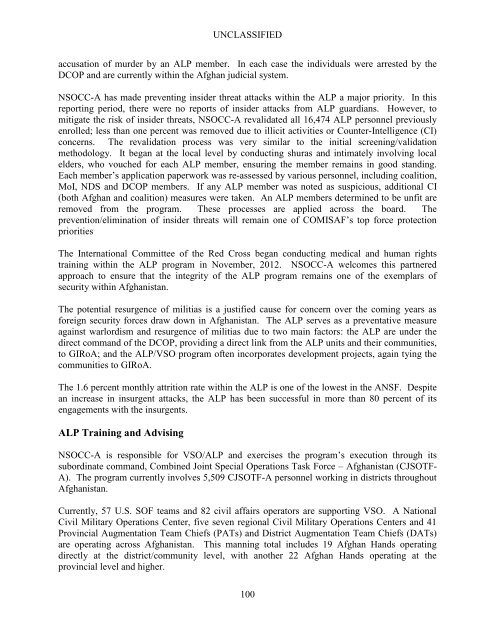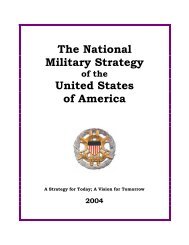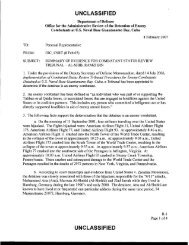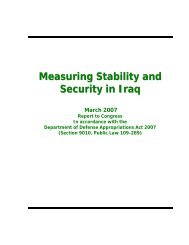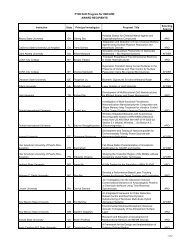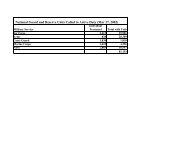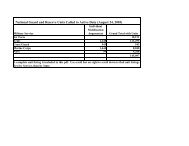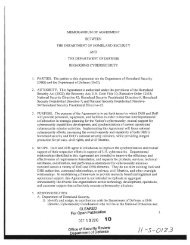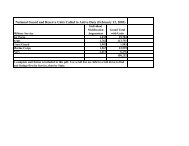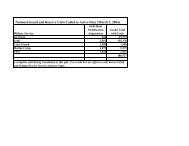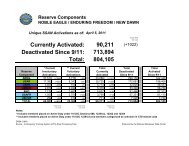Report - United States Department of Defense
Report - United States Department of Defense
Report - United States Department of Defense
You also want an ePaper? Increase the reach of your titles
YUMPU automatically turns print PDFs into web optimized ePapers that Google loves.
UNCLASSIFIED<br />
accusation <strong>of</strong> murder by an ALP member. In each case the individuals were arrested by the<br />
DCOP and are currently within the Afghan judicial system.<br />
NSOCC-A has made preventing insider threat attacks within the ALP a major priority. In this<br />
reporting period, there were no reports <strong>of</strong> insider attacks from ALP guardians. However, to<br />
mitigate the risk <strong>of</strong> insider threats, NSOCC-A revalidated all 16,474 ALP personnel previously<br />
enrolled; less than one percent was removed due to illicit activities or Counter-Intelligence (CI)<br />
concerns. The revalidation process was very similar to the initial screening/validation<br />
methodology. It began at the local level by conducting shuras and intimately involving local<br />
elders, who vouched for each ALP member, ensuring the member remains in good standing.<br />
Each member’s application paperwork was re-assessed by various personnel, including coalition,<br />
MoI, NDS and DCOP members. If any ALP member was noted as suspicious, additional CI<br />
(both Afghan and coalition) measures were taken. An ALP members determined to be unfit are<br />
removed from the program. These processes are applied across the board. The<br />
prevention/elimination <strong>of</strong> insider threats will remain one <strong>of</strong> COMISAF’s top force protection<br />
priorities<br />
The International Committee <strong>of</strong> the Red Cross began conducting medical and human rights<br />
training within the ALP program in November, 2012. NSOCC-A welcomes this partnered<br />
approach to ensure that the integrity <strong>of</strong> the ALP program remains one <strong>of</strong> the exemplars <strong>of</strong><br />
security within Afghanistan.<br />
The potential resurgence <strong>of</strong> militias is a justified cause for concern over the coming years as<br />
foreign security forces draw down in Afghanistan. The ALP serves as a preventative measure<br />
against warlordism and resurgence <strong>of</strong> militias due to two main factors: the ALP are under the<br />
direct command <strong>of</strong> the DCOP, providing a direct link from the ALP units and their communities,<br />
to GIRoA; and the ALP/VSO program <strong>of</strong>ten incorporates development projects, again tying the<br />
communities to GIRoA.<br />
The 1.6 percent monthly attrition rate within the ALP is one <strong>of</strong> the lowest in the ANSF. Despite<br />
an increase in insurgent attacks, the ALP has been successful in more than 80 percent <strong>of</strong> its<br />
engagements with the insurgents.<br />
ALP Training and Advising<br />
NSOCC-A is responsible for VSO/ALP and exercises the program’s execution through its<br />
subordinate command, Combined Joint Special Operations Task Force – Afghanistan (CJSOTF-<br />
A). The program currently involves 5,509 CJSOTF-A personnel working in districts throughout<br />
Afghanistan.<br />
Currently, 57 U.S. SOF teams and 82 civil affairs operators are supporting VSO. A National<br />
Civil Military Operations Center, five seven regional Civil Military Operations Centers and 41<br />
Provincial Augmentation Team Chiefs (PATs) and District Augmentation Team Chiefs (DATs)<br />
are operating across Afghanistan. This manning total includes 19 Afghan Hands operating<br />
directly at the district/community level, with another 22 Afghan Hands operating at the<br />
provincial level and higher.<br />
100


